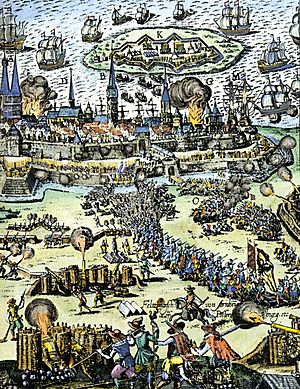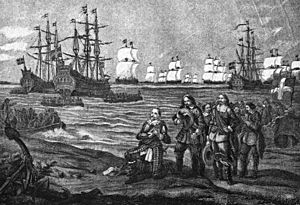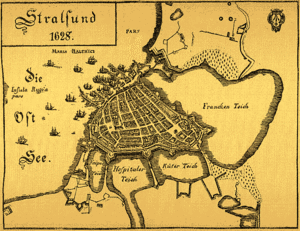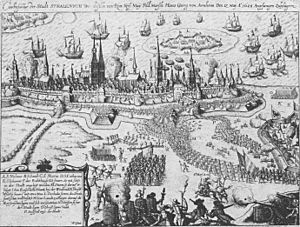Siege of Stralsund (1628) facts for kids
Quick facts for kids Siege of Stralsund |
|||||||
|---|---|---|---|---|---|---|---|
| Part of Thirty Years' War | |||||||
 An old drawing of the siege |
|||||||
|
|||||||
| Belligerents | |||||||
| Commanders and leaders | |||||||
The Siege of Stralsund was an important battle during the Thirty Years' War. It happened in 1628 in the city of Stralsund, which is now in Germany. An army led by Albrecht von Wallenstein tried to capture Stralsund. However, the city got help from Denmark and Sweden, including many brave Scottish soldiers.
The siege lasted from May 13 to August 4, 1628. Wallenstein's army failed to take the city. This loss was a big setback for Wallenstein. It also marked the first time Swedish soldiers were stationed on German land during the war. This battle showed that Sweden was now officially joining the fight.
Contents
Why Stralsund Was Important
Stralsund was a rich port city on the Baltic Sea. It was part of the Duchy of Pomerania. The city had a special status because it was a Hanseatic town. This meant it had a lot of freedom and did not have to follow all orders from the local dukes.
In 1627, the Duchy of Pomerania had to surrender to the Holy Roman Empire. This agreement was called the Capitulation of Franzburg. Wallenstein wanted to control all the ports on the Baltic Sea. This would stop his enemies from getting supplies by sea.
But Stralsund refused to give up. The city did not want Imperial troops inside its walls. Instead, Stralsund asked Denmark and Sweden for help.
Who Was Involved?
The Imperial Army
The Imperial Army was led by Albrecht von Wallenstein. He was a powerful general for the Holy Roman Emperor. Wallenstein had won many battles before coming to Stralsund. His goal was to control the entire Baltic coast.
The Defenders of Stralsund
Stralsund was defended by its own citizens. They had about 2,500 citizen soldiers and 1,500 local fighters. They also had 1,000 hired soldiers.
Christian IV of Denmark sent help to Stralsund. His army included many Scottish soldiers. In fact, many Scottish officers served in the Danish army.
Gustavus Adolphus of Sweden also sent troops. He was busy fighting a war with Poland at the time. But he saw Stralsund as a key place to help his plans in the Thirty Years' War.
The Battle Begins
In May 1628, Wallenstein's troops started to surround Stralsund. The first big attack happened between May 16 and 24.
On May 24, Danish help arrived. This force included 900 Scottish soldiers. They were led by Lieutenant Colonel Alexander Seaton.
The Imperial army attacked again on May 26 and 27. When they couldn't break through, Wallenstein's general, Hans Georg von Arnim, started bombing the city.
On June 20, Swedish help arrived. About 600 men came to support the city.
An Alliance for Stralsund
On June 23, Stralsund made an important agreement with Gustavus Adolphus of Sweden. They formed an alliance that would last for twenty years. This was a huge moment. It meant Sweden was now officially involved in the Thirty Years' War. Swedish soldiers were placed in Stralsund. This was the first time Swedish troops were stationed on German land.
Fierce Fighting
On June 27, Wallenstein himself took command of the Imperial forces. He immediately ordered new attacks. The Scottish troops fought very bravely. They defended a key part of Stralsund's walls.
One major attack was on the eastern part of the city. Major Robert Munro led the Scottish defenders there. Out of 900 Scots, 500 were killed and 300 were wounded. Munro himself was hurt. About 2,000 defenders were killed or captured in this attack. Munro later wrote that they were "not suffered to come off our posts for our ordinary recreation, nor yet to sleepe" for six weeks.
On June 28 and 29, Wallenstein's army managed to take some outer parts of the city's defenses.
More Help Arrives
On June 29, the Duke of Pomerania tried to convince Stralsund to surrender. But the city refused.
On June 30, ten Swedish ships arrived. They brought 600 more troops, even under heavy fire. Soon after, another Scottish regiment arrived. These troops, led by Alexander Lindsay, 2nd Lord Spynie, also suffered many losses.
On July 2, 400 more Danish troops arrived. In the next week, 1,100 more Danish-Scottish troops came.
By July 17, Scotsman Alexander Leslie arrived with 1,100 troops. He took over as Stralsund's governor. Leslie commanded between 4,000 and 5,000 soldiers. The Danish support during the siege totaled 2,650 troops.
Leslie immediately ordered a bold attack on Wallenstein's army. Robert Monro wrote that Leslie wanted to show the bravery of his Scottish countrymen.
Heavy rain from July 21 to 24 turned the battlefield into a muddy mess. Finally, on August 4, Wallenstein gave up. He lifted the siege. This was his first major defeat in the Thirty Years' War.
What Happened Next?
After failing to take Stralsund, Wallenstein moved to nearby Wolgast. He fought Christian IV of Denmark there. Danish troops had landed in the area and taken Wolgast. Wallenstein retook the town on August 22.

In August, Sweden's leader, Axel Oxenstierna, tried to talk with Wallenstein. But Wallenstein refused. Not being able to capture Stralsund was one of the reasons Wallenstein was later removed from his command in 1630.
When Gustavus Adolphus of Sweden invaded Pomerania in 1630, he used Stralsund as a safe base. His forces then pushed Wallenstein's army out of Pomerania. By June 1631, Swedish forces controlled the entire duchy.
The Siege of Stralsund is still remembered today. The people of Stralsund celebrate it every year with a festival called "Wallensteintage" (Wallenstein Days).
Images for kids
- Besieger
- Defendants
See also
- Thirty Years' War
- Duchy of Pomerania
- Swedish Pomerania
- Scotland and the Thirty Years' War









